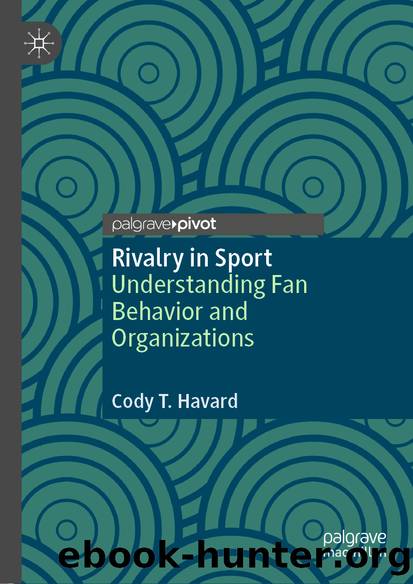Rivalry in Sport by Cody T. Havard

Author:Cody T. Havard
Language: eng
Format: epub
ISBN: 9783030474553
Publisher: Springer International Publishing
Review of Literature
Rivalry
Rivalry begins from a discussion of SIT, which posits that people will allow the groups in which they belong to influence their sense of self-esteem (Tajfel, 1974). When a person identifies and interacts with a group (i.e., in-group), he or she does so to protect the social identity derived from association with said group (Bergami & Bagozzi, 2000; Cameron, 1999) and can begin to adopt the identity of the collective (Crocker & Luhtanen, 1990). Further, because of the membership in an in-group and in the presence of perceived competition (Festinger, 1954), people will also choose an out-group to disidentify from (Elsbach & Bhattacharya, 2001). Intergroup behavior is on display when members of opposing groups interact (Sherif, 1966), which allows individuals to differentiate between members of the in-group and out-group (Brewer, 1979), and can lead to rivalrous relationships. Intergroup rivalry can be caused by the perceived threat to (Stephan, Ybarra, & Rios, 2016), the relative inferiority of (Leach & Spears, 2009; Leach, Spears, Branscombe, & Doosje, 2003), and the perceived distinctiveness of the in-group (see Jetten, Spears, & Manstead, 1999). Rivalry can also influence participant competition (Kilduff, 2014), motivation (Triplett, 1898), in-group bias (Sherif et al., 1961; Turner, 1975), unethical behavior (Kilduff et al., 2016), and hostility toward the out-group (Chang, Krosch, & Cikara, 2016).
Within the scope of marketing, rivalry influences the way consumers react to brands. For example, a sample of Apple users displayed schadenfreude toward the Microsoft brand (Phillips-Melancon & Dalakas 2014). Consumers of Coca-Cola and Pepsi Cola exhibited negativity toward not only the opposing brands but also consumers of those brands (Muniz Jr. & Hamer, 2001). Within management, research has shed light onto actions firms take to gain competitive advantage over rival firms (Capron & Chatain, 2008), factors that cause rivalry among companies offering similar and dissimilar products (Markman et al., 2009), and lessons that can be learned from corporate rivalries (Havard, 2020).
Download
This site does not store any files on its server. We only index and link to content provided by other sites. Please contact the content providers to delete copyright contents if any and email us, we'll remove relevant links or contents immediately.
Bullshit Jobs by David Graeber(4136)
Radical Candor by Kim Scott(2689)
I Am Right, You Are Wrong by Edward De Bono(2427)
23:27 by H. L. Roberts(2222)
Nomadland by Jessica Bruder(2036)
Average Is Over by Tyler Cowen(1822)
The Conflict Resolution Phrase Book by Barbara Mitchell & Cornelia Gamlem(1753)
Out of Our Minds: Learning to Be Creative by Ken Robinson(1715)
High-Impact Interview Questions by Victoria A. Hoevemeyer(1671)
Who Moved My Cheese?: An Amazing Way to Deal With Change in Your Work and in Your Life by Johnson Spencer(1626)
The Ideal Team Player by Patrick M. Lencioni(1618)
An Everyone Culture: Becoming a Deliberately Developmental Organization by Robert Kegan & Lisa Laskow Lahey(1616)
The Asshole Survival Guide by Robert I. Sutton(1576)
Automatic Society by Bernard Stiegler(1531)
Unleashed by Anne Morriss & Frances Frei(1510)
Who by Street Randy & Smart Geoff(1486)
42 Rules of Employee Engagement by Susan Stamm(1449)
96 Great Interview Questions to Ask Before You Hire by Paul Falcone(1433)
Fish! by Stephen C. Lundin(1374)
